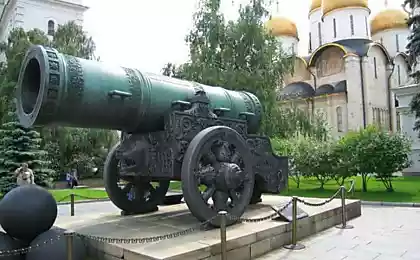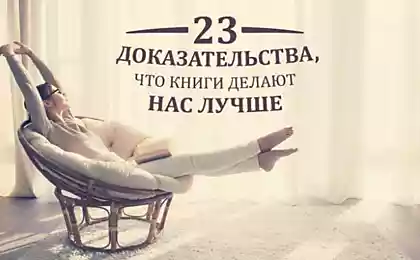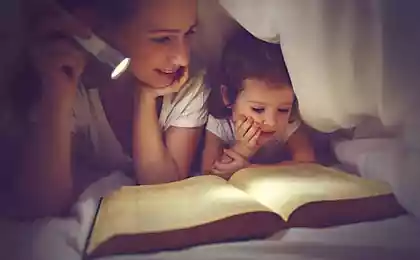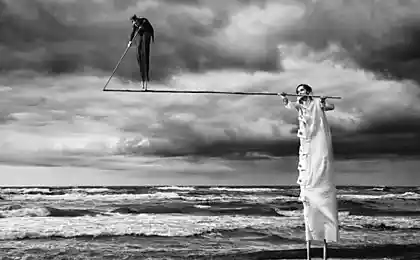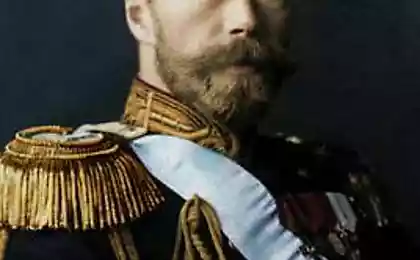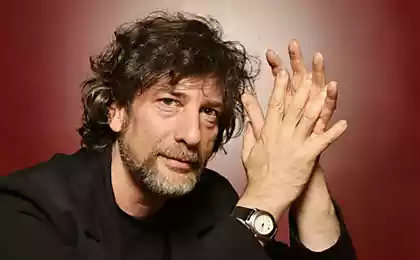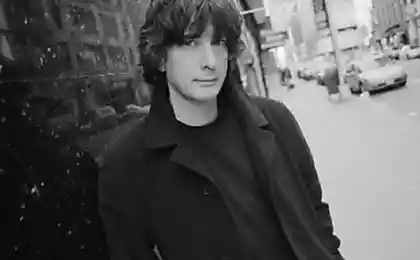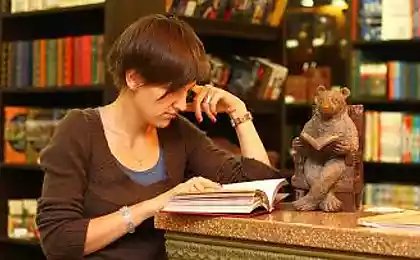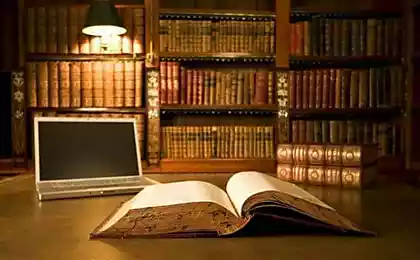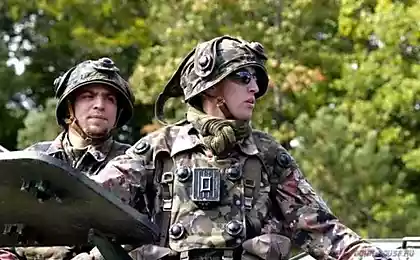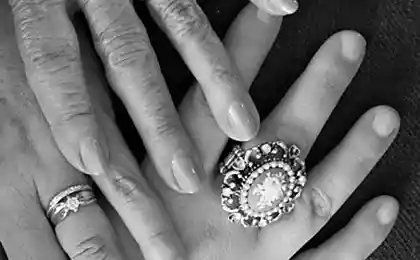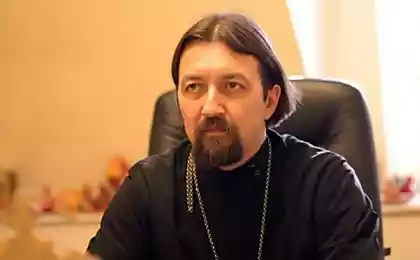580
And taught the king's children
Royal children from an early age began to prepare for the most important and challenging profession — the management of the state. In the Middle ages life expectancy was much shorter, and therefore the main event (coming of age, the beginning of military service and court career, marriage) usually occurred much earlier than today. The education of children also began at an earlier age.
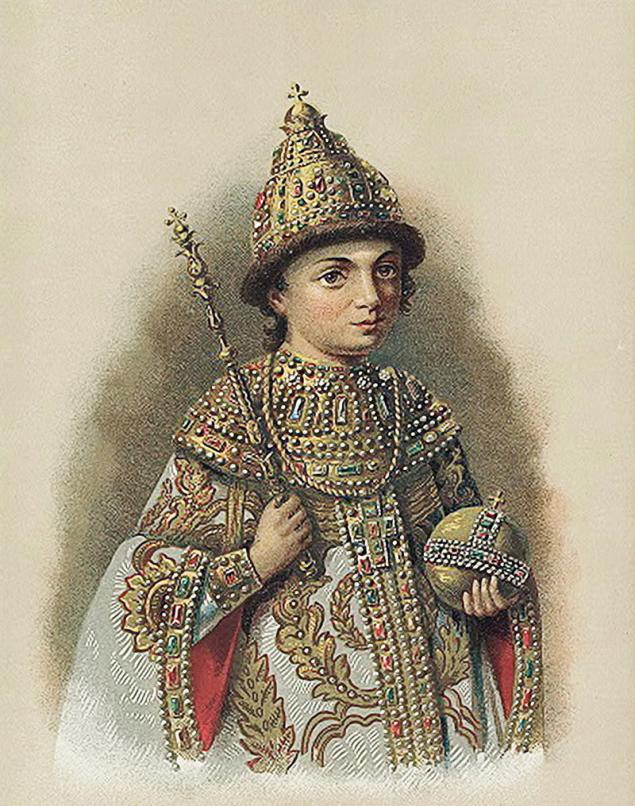
Peter I
Princes and princesses from the first years was surrounded by all possible care and luxury. They were the best in those days of toys: dolls, horses, silver animals and birds. Among the amusements of the Royal children from an early age consisted of children's books. At the Royal court was a widespread tradition of making "funny books", ie, handwritten books with pictures which court artists painted to special order in a single instance.
So, the Tsarevich Peter Alexeyevich made his first comic book when he was only one year. In 1674 for tsarevna Natalia Alexeyevna, who was born in August 1673, the book was written "the Firstfruits of the creation of the world." In addition, from an early age, the Royal children were to study the genealogy of his dynasty. To them were ordered "book of the pious and godly Power of the Romanov dynasty". B XVIII century in Russia was much loved by translated tales of chivalry. "The story of Beauvais Korolevich "persons", i.e., with illustrations, was listed among comic books infant Tsarevich Alexei Petrovich. With all of these books the kids learn, when they themselves could not read — they read aloud to someone close to me.
Learning the reading of the king's children began at the age of about 5 years. So, the five-year Prince Petru by the decision of the older brother, Tsar Fedor Alekseevich — choose the teacher, who was a clerk Nikita Zotov.
First means learning to read was the alphabet. Patriarch Filaret Nikitich in 1633 blessed his four-year grandson, Tsarevich Alexei Mikhailovich "ABC, large print". Apart from the hard primers in the court life there were also handwritten. One of these primers is currently in the collection of Moscow Kremlin Museums. Handwriting ABC book consists of 26 pages and begins with a reference to the Tsarevich Alexey Petrovich. Further, each sheet contains the letters of the alphabet of that time, accompanied by drawings and text in verse.
For example, the letter P is illustrated by everyday objects, familiar to every man of the time: ward, ring, musket, sail, sash, feather, sling, button:
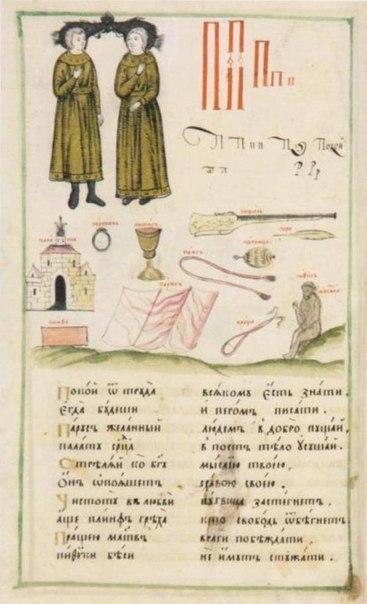
page of the letter p in the primer
The presence in the drawings the letter R the rod says that this item was known in the Royal Palace. In addition to the primers, in the historical sources is mentioned and ABC columns — the recipe, which was performed by scribes-calligraphers of the Embassy of the order. I must say that in those days to be able to read was much harder than now — because in addition to printed books existed and handwritten documents, executed in different hands.
Training usually occurred in the wards of the Royal children. In the second half of the XVII century mention a "didactic naloy" — probably the sort of desks. Documents, telling about the teachings of Prince Fedor Alekseevich, also say that the Royal child learns to read at "learning bench", trimmed in gold braid with silver. Is said about a special "didactic house" Prince, i.e., an area specially designed for training. We also started to learn quite early in the morning, earlier than is customary now — if in the modern school, lessons begin at 8.00 or 8.30 in the XVII century classes almost certainly began with the daily Affairs of adults — at 6 o'clock in the morning. However, the training process went very quickly — apparently, fun and games still played in the lives of Royal children an important role.
After alphabet for learning to read used religious books — prayer-book, Psalms and the acts of the apostles. The goal of learning to read in those days was that people could read the sacred books for the salvation of his soul. Decorated with colorful images of the Psalter XVII century as the best suited for teaching reading: on every page there are several lines of text and illustrative miniature.
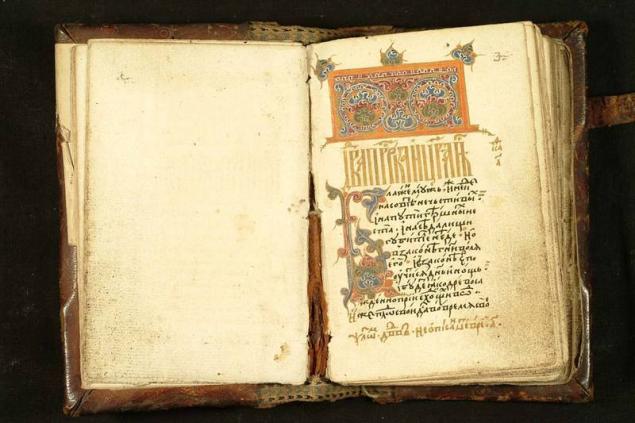
page from the manuscript of the Psalter
If now children are learning to read and write at the same time, in the Middle ages it was not so. Only after learning to read the turn of the letter. Often mention the people who could read but could not write. Beautiful and clear handwriting was considered in all countries as one of the main signs of a good education, so to write Royal children were taught by the best calligraphers of the time — the clerks and the clerks of the Ambassadorial order.
In the compulsory program of education of that time was also part of Church singing, who could learn from hearing and using "hooks" — types of notes. Church singing was very fond of the Tsar Ivan the terrible, and succeeded in it the daughter of Tsar Boris Godunov, Princess Xenia, the musical talent which is also referred to by his contemporaries. Many Russian rulers themselves wrote the lyrics or music to Church hymns. Historians of music of the famous works of the kings of Ivan the terrible and his older brother Peter, Tsar Fedor Alekseevich. In the primer of Tsarevich Alexei Petrovich has a song called "Music — singing sweet", which shows young people playing various musical instruments. The initial stage of learning of all children, including king's, ended on the teaching of reading, writing and Church singing.
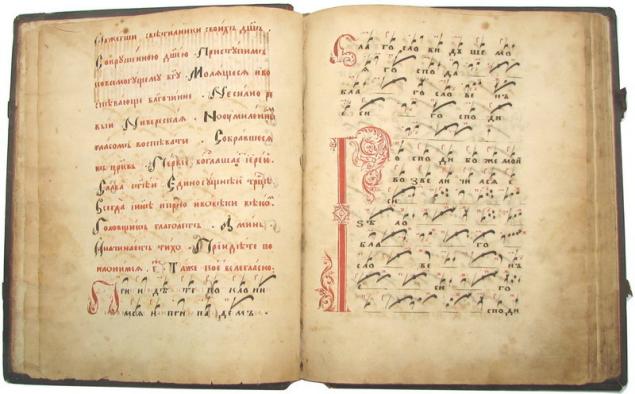
the book with the hook notes
What are studied Royal children in the next phase, the "high school"?
Much attention in training the king's children has long been focused on history. To explore the world of history has been the so-called Chronographs, where the presentation often begins with biblical and ancient times.
Russian history was studied through a huge illustrated chronicle, created by the order of Ivan the terrible — Facial Chronicles. As for geography, the information that the Royal children studied this science appear in the times of Tsar Boris Godunov. Contemporaries mention the fact that his son Prince Fedor Borisovich not only taught geography, and he drew a map of the Russian state, as well as a detailed drawing of the Kremlin and Moscow.
The issue of learning foreign languages is one of the most difficult. Tsar Ivan the terrible on the techniques of Polish and Tatar ambassadors were told that needs no interpreter. Apparently, the languages of the nearest neighbors in those days were taught from the hearing, but the special teaching of foreign languages was not.
But the main occupation of the sovereign was considered military — after all, the king had to lead an army as commander in chief. From an early age for the fun of the king's sons served as toy swords, guns and cannons. Court masters did for them amusing banners and drums. At the age of 6-7 years the Royal armourers were performed for princes the armour and helmets to fully replicate the real thing. Preserved helmet of Prince Ivan, son of Ivan the terrible. Royal children were also taught archery and rifles, horse riding and other military skills.
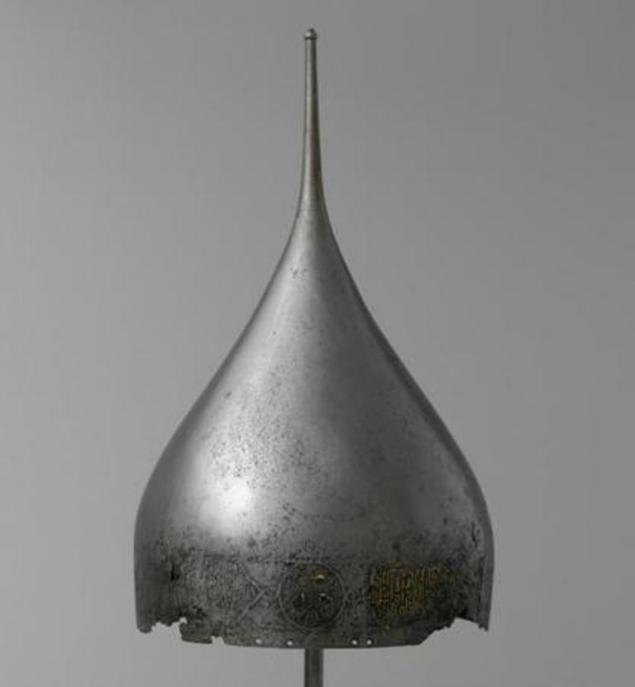
helmet of Prince Ivan
By the time of accession to the throne of the Royal sons were trained to the main tasks that stood in front of the ruling Emperor. They could show his piety in the Church during the festive service and procession to take action on petitions and other documents received in their name, worthy to receive foreign ambassadors and to lead the army during a military campaign. In those days a king who could lead the military and judicial Affairs, was considered a model Emperor, worthy of respect nationals. For all other cases there was government officials — nobles, and clerks clerks.published
Author: Marina Rakitina
P. S. And remember, just changing your mind - together we change the world! ©
Source: thezis.ru/chemu-i-kak-uchili-tsarskih-detey.html

Peter I
Princes and princesses from the first years was surrounded by all possible care and luxury. They were the best in those days of toys: dolls, horses, silver animals and birds. Among the amusements of the Royal children from an early age consisted of children's books. At the Royal court was a widespread tradition of making "funny books", ie, handwritten books with pictures which court artists painted to special order in a single instance.
So, the Tsarevich Peter Alexeyevich made his first comic book when he was only one year. In 1674 for tsarevna Natalia Alexeyevna, who was born in August 1673, the book was written "the Firstfruits of the creation of the world." In addition, from an early age, the Royal children were to study the genealogy of his dynasty. To them were ordered "book of the pious and godly Power of the Romanov dynasty". B XVIII century in Russia was much loved by translated tales of chivalry. "The story of Beauvais Korolevich "persons", i.e., with illustrations, was listed among comic books infant Tsarevich Alexei Petrovich. With all of these books the kids learn, when they themselves could not read — they read aloud to someone close to me.
Learning the reading of the king's children began at the age of about 5 years. So, the five-year Prince Petru by the decision of the older brother, Tsar Fedor Alekseevich — choose the teacher, who was a clerk Nikita Zotov.
First means learning to read was the alphabet. Patriarch Filaret Nikitich in 1633 blessed his four-year grandson, Tsarevich Alexei Mikhailovich "ABC, large print". Apart from the hard primers in the court life there were also handwritten. One of these primers is currently in the collection of Moscow Kremlin Museums. Handwriting ABC book consists of 26 pages and begins with a reference to the Tsarevich Alexey Petrovich. Further, each sheet contains the letters of the alphabet of that time, accompanied by drawings and text in verse.
For example, the letter P is illustrated by everyday objects, familiar to every man of the time: ward, ring, musket, sail, sash, feather, sling, button:

page of the letter p in the primer
The presence in the drawings the letter R the rod says that this item was known in the Royal Palace. In addition to the primers, in the historical sources is mentioned and ABC columns — the recipe, which was performed by scribes-calligraphers of the Embassy of the order. I must say that in those days to be able to read was much harder than now — because in addition to printed books existed and handwritten documents, executed in different hands.
Training usually occurred in the wards of the Royal children. In the second half of the XVII century mention a "didactic naloy" — probably the sort of desks. Documents, telling about the teachings of Prince Fedor Alekseevich, also say that the Royal child learns to read at "learning bench", trimmed in gold braid with silver. Is said about a special "didactic house" Prince, i.e., an area specially designed for training. We also started to learn quite early in the morning, earlier than is customary now — if in the modern school, lessons begin at 8.00 or 8.30 in the XVII century classes almost certainly began with the daily Affairs of adults — at 6 o'clock in the morning. However, the training process went very quickly — apparently, fun and games still played in the lives of Royal children an important role.
After alphabet for learning to read used religious books — prayer-book, Psalms and the acts of the apostles. The goal of learning to read in those days was that people could read the sacred books for the salvation of his soul. Decorated with colorful images of the Psalter XVII century as the best suited for teaching reading: on every page there are several lines of text and illustrative miniature.

page from the manuscript of the Psalter
If now children are learning to read and write at the same time, in the Middle ages it was not so. Only after learning to read the turn of the letter. Often mention the people who could read but could not write. Beautiful and clear handwriting was considered in all countries as one of the main signs of a good education, so to write Royal children were taught by the best calligraphers of the time — the clerks and the clerks of the Ambassadorial order.
In the compulsory program of education of that time was also part of Church singing, who could learn from hearing and using "hooks" — types of notes. Church singing was very fond of the Tsar Ivan the terrible, and succeeded in it the daughter of Tsar Boris Godunov, Princess Xenia, the musical talent which is also referred to by his contemporaries. Many Russian rulers themselves wrote the lyrics or music to Church hymns. Historians of music of the famous works of the kings of Ivan the terrible and his older brother Peter, Tsar Fedor Alekseevich. In the primer of Tsarevich Alexei Petrovich has a song called "Music — singing sweet", which shows young people playing various musical instruments. The initial stage of learning of all children, including king's, ended on the teaching of reading, writing and Church singing.

the book with the hook notes
What are studied Royal children in the next phase, the "high school"?
Much attention in training the king's children has long been focused on history. To explore the world of history has been the so-called Chronographs, where the presentation often begins with biblical and ancient times.
Russian history was studied through a huge illustrated chronicle, created by the order of Ivan the terrible — Facial Chronicles. As for geography, the information that the Royal children studied this science appear in the times of Tsar Boris Godunov. Contemporaries mention the fact that his son Prince Fedor Borisovich not only taught geography, and he drew a map of the Russian state, as well as a detailed drawing of the Kremlin and Moscow.
The issue of learning foreign languages is one of the most difficult. Tsar Ivan the terrible on the techniques of Polish and Tatar ambassadors were told that needs no interpreter. Apparently, the languages of the nearest neighbors in those days were taught from the hearing, but the special teaching of foreign languages was not.
But the main occupation of the sovereign was considered military — after all, the king had to lead an army as commander in chief. From an early age for the fun of the king's sons served as toy swords, guns and cannons. Court masters did for them amusing banners and drums. At the age of 6-7 years the Royal armourers were performed for princes the armour and helmets to fully replicate the real thing. Preserved helmet of Prince Ivan, son of Ivan the terrible. Royal children were also taught archery and rifles, horse riding and other military skills.

helmet of Prince Ivan
By the time of accession to the throne of the Royal sons were trained to the main tasks that stood in front of the ruling Emperor. They could show his piety in the Church during the festive service and procession to take action on petitions and other documents received in their name, worthy to receive foreign ambassadors and to lead the army during a military campaign. In those days a king who could lead the military and judicial Affairs, was considered a model Emperor, worthy of respect nationals. For all other cases there was government officials — nobles, and clerks clerks.published
Author: Marina Rakitina
P. S. And remember, just changing your mind - together we change the world! ©
Source: thezis.ru/chemu-i-kak-uchili-tsarskih-detey.html
The Russian mathematician has found a proof of the Riemann Hypothesis
The gates of Paradise and the gates of hell
